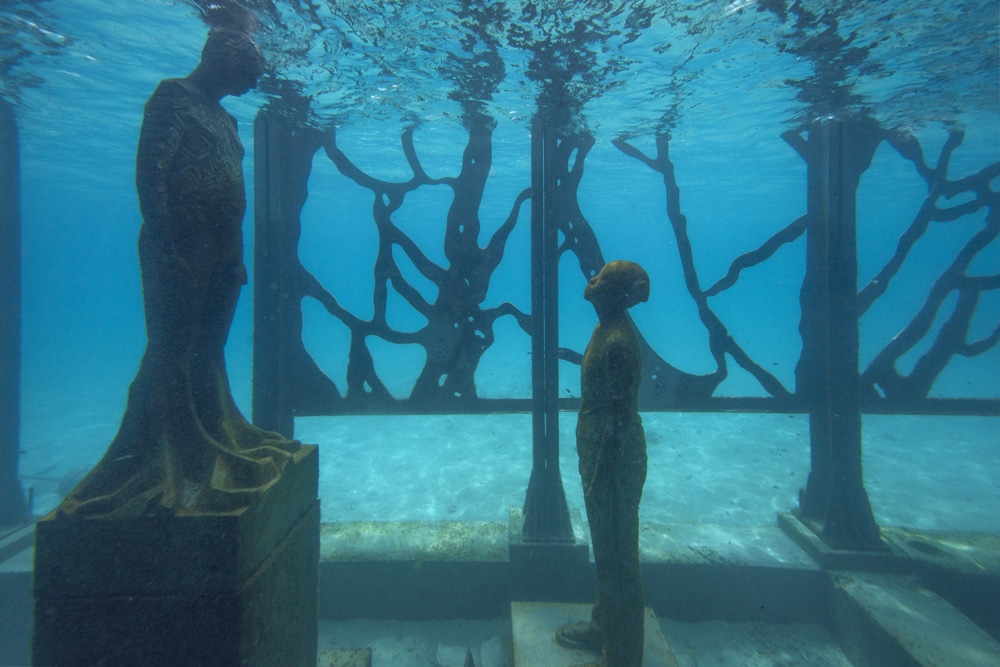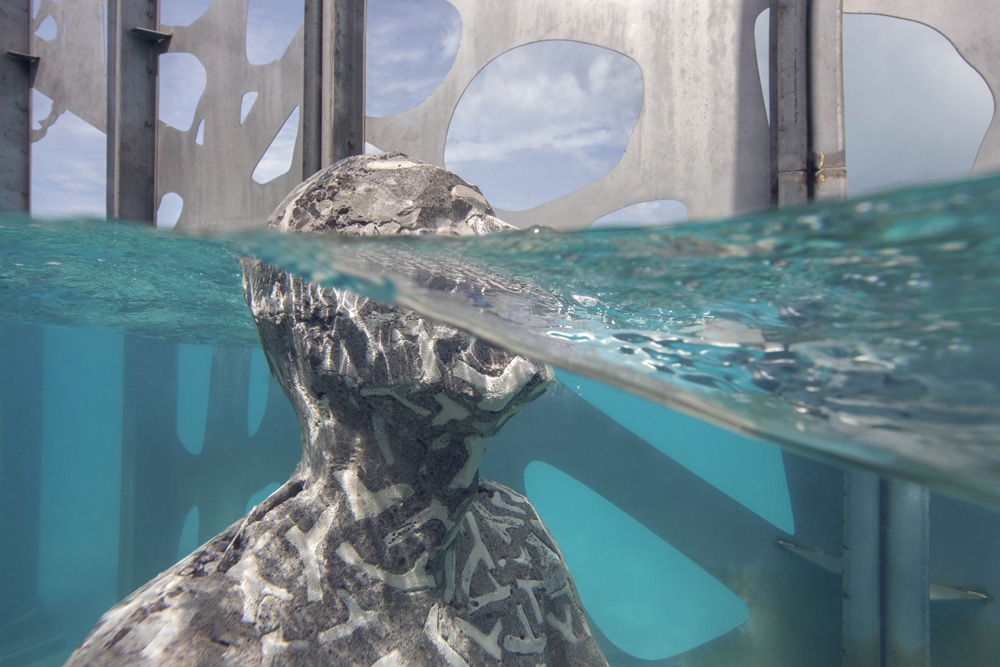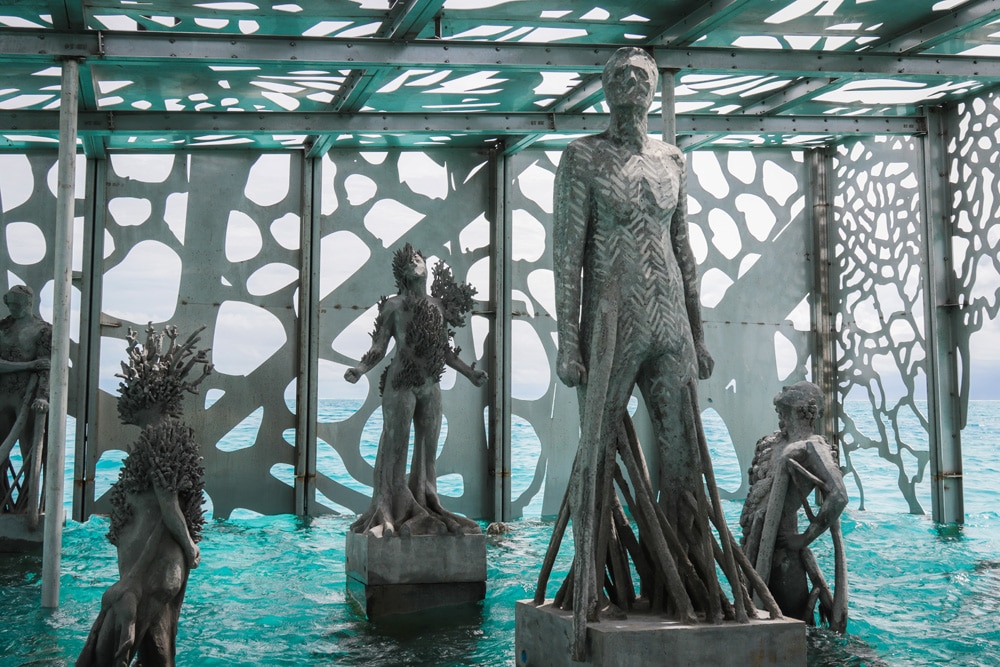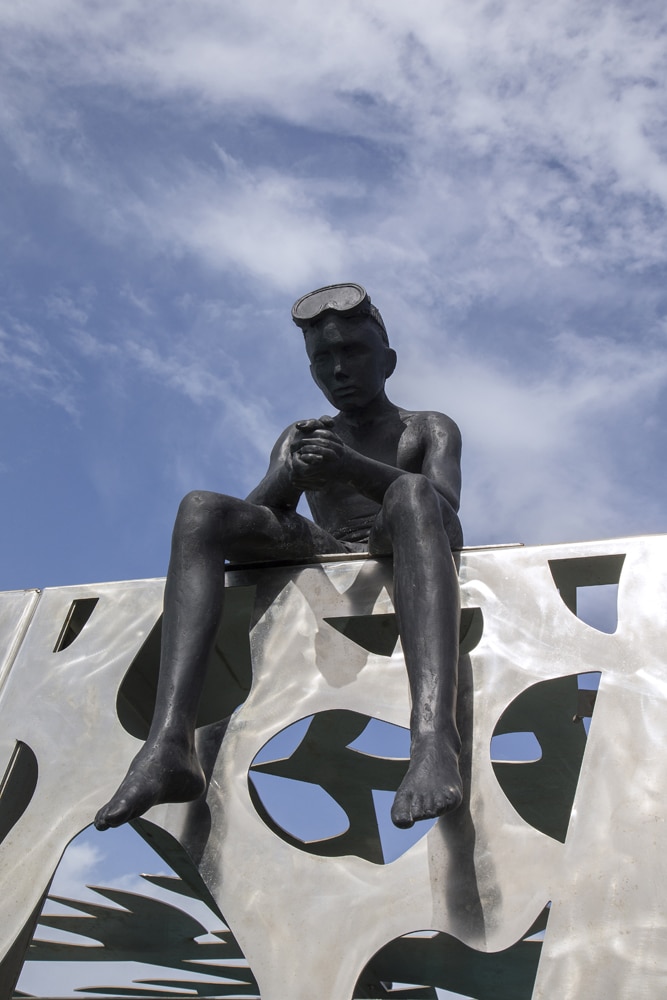News
World’s first Inter-tidal Gallery: Coralarium
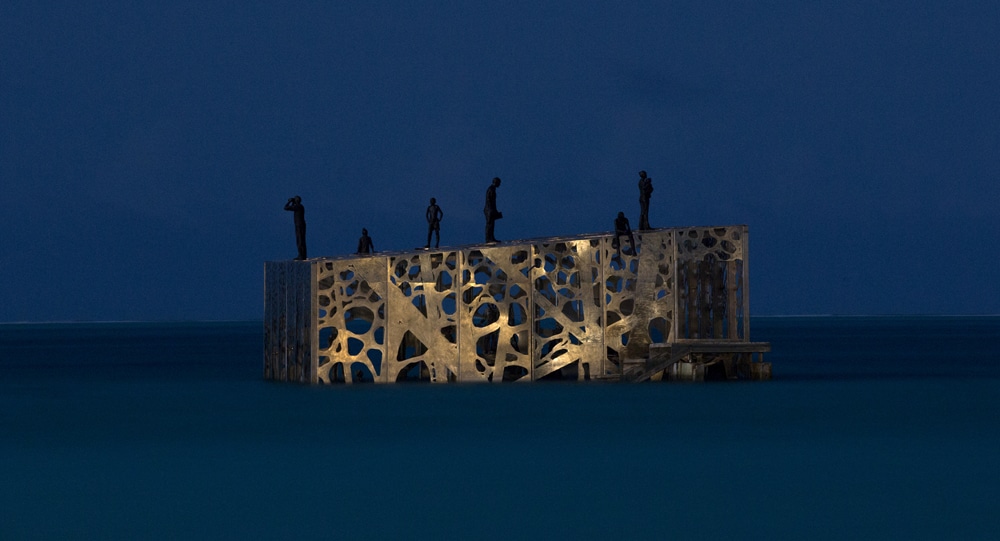
WHERE LAND, SEA & ART COLLIDE
The Sculpture Coralarium is situated in the centre of the largest developed coral lagoon in the Maldives, on the island resort of Fairmont Maldives Sirru Fen Fushi. The artwork created by renowned environmental sculptor Jason deCaires Taylor is a semi-submerged tidal gallery space that exhibits a series of sculptural artworks on the skyline, inter-tidal waterline and seabed. The work aims to create a direct pathway to the ocean.
A long swimming pool transects the island and denotes the starting point. The art installation begins by following this line into the clear shallow waters of the sea where an underwater coral pavement begins. Sea-scaped with underwater poplar trees and endemic planted corals it heads 100m through the shallows towards the underwater realm, a symbolic pathway to another world and the starting point of the artistic intervention. After a 50m snorkel/swim you encounter a submerged staircase which leads up towards a semi submerged tidal building. The building is cube shaped, six metres tall, with its front facade submerged up to median tide of three metres. The design of the walls is based on natural coral structures and is porous to allow the tides, current and marine life to pass through it and the structure to “breathe” within its location.
The complex structural formation is designed to dissipate oceanic forces whilst creating a protective space that encourages nature to colonise and seek refuge. The construction, using high grade, polished, marine stainless steel aims to reflect and mirror the surrounding blues of the coral atoll and the sky above. A mirage on the horizon, that over time will take on the patina of the sea as it becomes colonised by algae and weathers within the environment. The roof of the building houses a series of black silhouetted sculptures that connect both the sky above and the sea below, occupying a space between worlds.
The entrance of the building is situated above water and leads into a dry elevated viewing platform. The square gallery space exhibits a further 14 sculptures on plinths at various heights within the water column, some works completely submerged, others high above the water line, with the majority mid water interacting with both the marine and terrestrial world depending on the tidal level. The roof is perforated with a coral pattern to allow beams of light to illuminate the individual works and a series of submerged lights to illuminate the space during the night. The sculptures themselves are hybrid forms, part-human, part-plant, part-coral. The organic forms are based on endemic species of the island and its surrounding reefs; banyan trees, screw pines, strangler ivy, mushroom and staghorn corals. Many of the works feature root systems, symbolic of the dependence of humans on the natural environment a connection to place.
White calcium coral skeletons, formed of bones ingrained into the surface of works, aims to show how the reef is part of the Maldivian DNA. Leaves on the base of the plinths will provide additional marine habitat space. The underwater realm of the installation includes a series of children looking up towards the surface of the sea posing questions about the threat of climate change and sea levels rising and the consequences for future generations. Overall the installation aims to draw all the elements of life on earth together, to portray a system where all components are dependant on each other, humans and the environment in coexistence, a levelling of relationships. The Coralarium becomes a portal or interface to the wonders of the underwater world.
Access to the Coralarium with be through guided tours in small groups lead by the resort’s resident marine biologists and are available several times a day.
CORALARIUM FACTS
- World’s first semi-submerged art gallery
- Maldives first underwater museum
- 180 tons of architectural elements
- 66 marine grade stainless steel panels
- 432 sqm of laser cut stainless steel
- 10 hybrid-organic sculptures on plinths
- 6 fully submerged sculptures on the seafloor
- 6 rooftop sculptures
- 6 fully submerged popular trees seaming coral pathway
- Coral pathway with over 60 coral flower pots growing over 200 cuttings of staghorn coral
- Local design inspirations: Strangler Ivy, Banyan Tree roots, Mushroom Coral, Staghorn coral, Gorgonian Fan coral, bread fruit
- 5 months of installation period on the island
HOW TO GET THERE
Shaviyani Atoll, North Maldives. Reachable by scenic seaplane transfer, 55 minutes from Velana International Airport, alternatively transfers can be arranged via domestic flight to Hanimaadhoo Airport followed by speedboat transfer to the island.
For more information about the museum –
Email: underwatermuseum.maldives@fairmont.com
Website: www.fairmont-maldives.com
For more information about the works of underwater naturalist and artist Jason deCaires Taylor, please visit: www.underwatersculpture.com
News
Book Review: Fire on Monroe Bravo by Fred Lockwood

Fire on Monroe Bravo is the latest book in the Jack Collier series by Fred Lockwood. Our story begins with our lead characters, Jack and Sandro, owners of Marine Salvage & Investigation Company, arriving on the Monroe Bravo Oil & Gas Platform in the North Sea. Having secured a contract for their vessel the MV Stavanger to act as support ship to the platform for TransGlobal Oil, our protagonists are on a celebratory visit.
However almost as soon as they arrive a series of explosions rock the platform, causing huge damage, loss of life and the very real danger of a massive human, ecological and financial disaster.

As the danger mounts for both our heroes and the surviving workers, Jack and Sandro will have to escape the inferno, all while trying to save the platform and the men still trapped unable to help themselves.
The disaster sets the scene for the unfolding story lines following the fate of the platform and our main characters, the police investigation into a suspected terrorist act and the actions of TransGlobal Oil as they attempt to navigate the pubic outcry and financial repercussions.
In his eighth book, Fire on Monroe Bravo, Fred Lockwood delivers an explosive thriller, with plenty of above and in-water drama, and our heroes fighting for survival, what more can you ask for?
We thoroughly recommend this read and look forward to the next in the series. For more information about his book series, you can check out the reviews of his previous books here on Scubaverse.
- Title: Fire On Monroe Bravo
- Author: Fred Lockwood
- ISBN: 979-8325324536
Available in a paperback version and for Kindle from Amazon and book stores.
Blogs
Alonissos: The complete diving destination (Part 1)

In June we were incredibly fortunate to be invited to dive in Alonissos, a small Greek Island in the Sporades island chain located in the North Aegean Sea. While I have long been a big fan of the Greek Islands as a great holiday destination, I had not had the opportunity to do any diving on previous visits and Mike and I were extremely excited to see what Alonissos had to offer both above and below the surface!

The Sporades are easily accessible via the airport in Skiathos (the first island in the chain), which is served by Jet2 flights from all major UK airports from May through October. Numerous ferries and charter boats make island hopping from Skiathos Town a breeze. After an hour boat ride, the picturesque port of Patitiri was a wonderful introduction to Alonissos, where we were met by our gracious hosts Kostas of Albedo Travel and Dias of Alonissos Triton Dive Center. Mike and I were delighted to be staying at the Paradise Hotel, aptly named for its stunning views over the sea and great location for walking to the waterfront.

Alonissos is beautifully situated in the National Marine Park of Alonissos and the Northern Sporades, the largest marine protected area in Europe. The surrounding seas offer fabulous marine life, including incredibly rare species such as the Mediterranean monk seal. They boast deep walls covered in gorgonians and sponges, stunning topography with caverns, swimthroughs and pinnacles, and the first accessible ancient shipwreck from 500BC!

In locations where historical sites have been reported, the waters are largely restricted, but with collaboration between government, underwater archeologists and dive centres, incredible underwater museums are being created for a truly unique diving experience. Alonissos is home to the first of these, the Ancient Shipwreck of Peristera Accessible Underwater Archeological Site. The chance to dive into history (along with reports of healthy reef life and amazing underwater topography) meant Mike and I were keen to get in the water.

Our introduction to the diving around Alonissos was at the Agios Georgios Pinnacles, in the channel between Alonissos and Skopelos. This fantastic site was named “The Chimney,’ and proved to have a huge amount to see. We got to a decent depth here (over 25m), and marvelled at a colourful reef wall with a wonderful swim through whose rocky walls were absolutely covered with life. As well as brilliant topography there was no shortage of macro life here. We saw numerous nudibranchs, five different species in total. The second dive at Mourtias reef nearby was a shallower dive along a nice wall with lots of crevices. Several moray eels and grouper called this site home. We enjoyed looking in the crevices for lobster and smaller benthic life, such as cup corals and tunicates.

Our itinerary allowed us two dives a day with afternoons left to explore the island with our hire car and evenings to enjoy the famous Greek hospitality. This proved to be a lovely mix of in-water and land based diversions.

The next days diving to the Gorgonian Gardens and Triton’s Cave was to be even better! These two stunning sites are nothing short of fabulous. The Gorgonian Gardens was a deep wall near to the Agios Georgios islands. The ever-present currents in this deep channel meant that the sea life was amazing … the namesake Gorgonian sea fans dotted the wall at a depth of 30 to 50 meters, getting ever larger the deeper we went. Above 30m was by no means less beautiful, with sponges, corals, scorpionfish, moray eels and some rare and colourful nudibranchs.

The second shallower dive of the day was to Triton’s Cave or the Cavern of Skopelos, on the east side of that island. The spectacular rock formations had wild striations both above and below the water making a truly epic topography. The cavern entrance was at 14m, and big enough for a buddy pair, winding up to 6m and passing two beautiful windows out into the blue. Emerging from the cavern, the light at the shallower depths and the incredible rock formations made for a fantastic gentle swimming safety stop and we all surfaced by the boat with massive grins.

Check out our next blog :Alonissos: The complete diving destination (Part 2)” to hear about our amazing dive on the 2500 year old Peristera Wreck!
Thanks to:
Alonissos Triton Dive Center https://bestdivingingreece.com/
Albedo Travel https://alonissosholidays.com/activities/
Paradise Hotel https://paradise-hotel.gr/
Alonissos Municipality https://alonissos.gr/en/
-

 Blogs2 months ago
Blogs2 months agoDiving With… Nico, Ocean Earth Travels, Indonesia
-

 News1 month ago
News1 month agoMurex Bangka Announce New Oceanfront Cottages & Beachfront Dining
-

 Blogs2 months ago
Blogs2 months agoA new idea in freediving from RAID
-

 Marine Life & Conservation1 month ago
Marine Life & Conservation1 month agoIceland issue millionaire whale hunter a licence to murder 128 vulnerable fin whales
-

 Marine Life & Conservation2 months ago
Marine Life & Conservation2 months agoThe Shark Trust Great Shark Snapshot is back
-

 News3 months ago
News3 months agoCharting New Waters; NovoScuba Goes Global with the Launch of their Revolutionary Dive Training Agency!
-

 Gear News1 month ago
Gear News1 month agoNew Suunto Ocean – a dive computer and GPS sports watch in one for adventures below and above the surface
-

 Marine Life & Conservation Blogs2 months ago
Marine Life & Conservation Blogs2 months agoBook Review: Plankton


